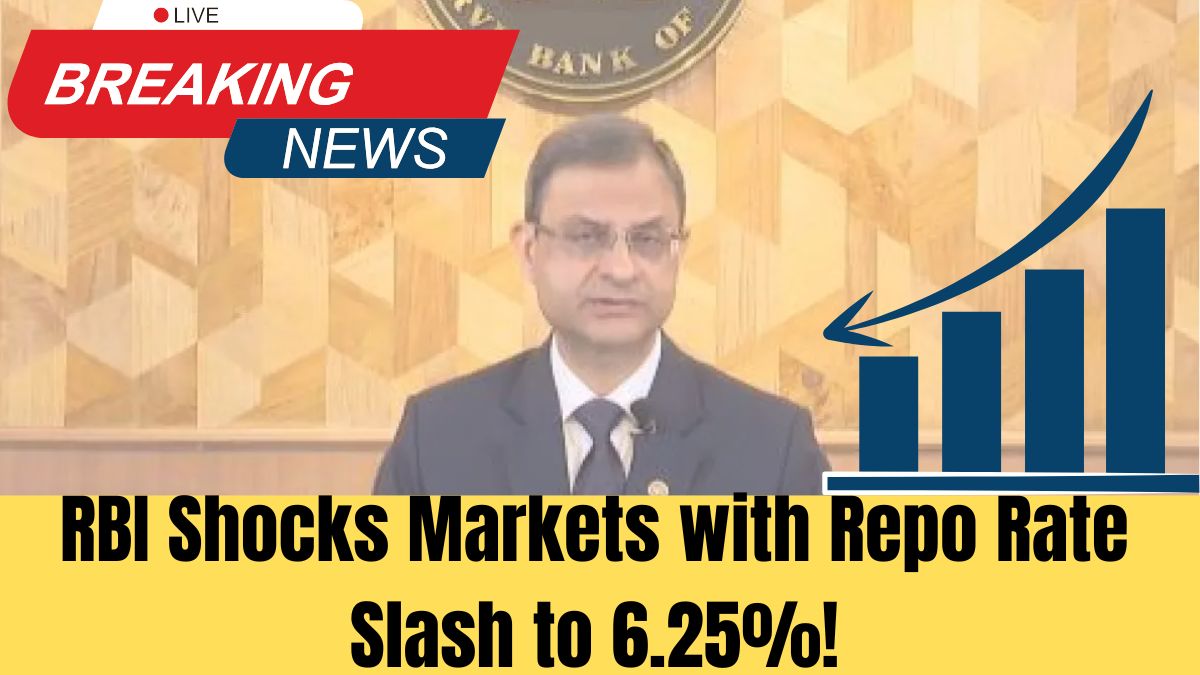The repo rate is the interest rate at which the Reserve Bank of India (RBI) lends money to commercial banks. It is one of the most critical tools for regulating liquidity in the economy.
A lower repo rate means cheaper loans for banks, encouraging them to reduce lending rates for customers. This can lead to lower home loan, auto loan, and personal loan interest rates, which boosts spending and investment.
Conversely, when the RBI increases the repo rate, borrowing becomes expensive, discouraging excessive spending to control inflation.

Why Did the RBI Reduce the Repo Rate?
The RBI’s Monetary Policy Committee (MPC) decided to cut the repo rate by 25 basis points, bringing it down from 6.5% to 6.25%. This is the first repo rate cut in five years.
Reasons for the Repo Rate Cut:
- Boost Economic Growth: Lower borrowing costs encourage investment and spending.
- Control Inflation: Inflation has remained within the RBI’s target range, allowing flexibility for rate cuts.
- Post-Pandemic Recovery: The economy is stabilizing after the pandemic, but growth needs a further push.
- Encourage Loan Borrowing: Businesses and individuals will find it cheaper to take loans.
This move aligns with the government’s recent reduction in personal income taxes to increase disposable income and boost consumption.
How Will the Repo Rate Cut Affect Borrowers?
A lower repo rate means banks may lower their lending rates, reducing the Equated Monthly Installments (EMIs) on loans. This is especially beneficial for borrowers with home, auto, and personal loans linked to floating interest rates.
Impact on Different Types of Borrowers:
| Loan Type | Expected Impact |
|---|---|
| Home Loans | Lower EMIs for new borrowers, and possible rate reduction for existing ones. |
| Personal Loans | Reduced interest rates, making borrowing more affordable. |
| Auto Loans | EMI relief for borrowers financing vehicle purchases. |
| Business Loans | More accessible credit for small and medium enterprises (SMEs). |
For example, if you have a ₹50 lakh home loan with an 8.5% interest rate for 20 years, your EMI would be around ₹43,391. After the repo rate cut, if your bank reduces the interest rate to 8.25%, your EMI will drop to ₹42,458—saving ₹933 per month.
How Does a Repo Rate Cut Influence the Economy?
Lower interest rates stimulate economic growth in the following ways:
- Encourages Consumer Spending: Lower loan rates increase purchasing power, benefiting real estate, automobile, and consumer electronics sectors.
- Boosts Business Investments: Cheaper credit allows businesses to expand, hire more employees, and increase production.
- Increases Stock Market Optimism: Investors see lower interest rates as a sign of economic growth, leading to stock market rallies.
- Can Weaken the Rupee: Lower rates can reduce foreign investment, affecting the rupee’s value against global currencies.
However, the RBI has maintained a “neutral” stance, meaning it will monitor inflation trends and global economic conditions before making further changes.
Will Banks Pass the Benefit to Customers?
The repo rate cut only benefits borrowers if banks reduce their lending rates. Banks decide their interest rates based on multiple factors, including their cost of funds and credit demand.
- Loans linked to the External Benchmark Lending Rate (EBLR) will see an immediate reduction in interest rates.
- Loans based on Marginal Cost of Funds-based Lending Rate (MCLR) may take time to reflect changes.
If banks do not pass on the full rate cut, customers may consider negotiating with their lenders or switching to a lower interest rate loan.
RBI’s Steps to Combat Cyber Fraud in Digital Banking
With the rapid digitalization of financial services, RBI Governor Sanjay Malhotra has also announced measures to combat cyber fraud:
- Exclusive “.bank.in” domains for Indian banks to prevent fraud.
- Dedicated “.fin.in” domains for other financial institutions.
- Enhanced authentication layers for international digital transactions to curb fraudulent activities.
These steps aim to improve cybersecurity while making online transactions more secure.
Frequently Asked Questions
What is the current repo rate after the latest RBI decision?
The repo rate has been reduced to 6.25% from the previous 6.5%, marking a 25 basis point cut.
Will my home loan EMI decrease immediately?
If your loan is linked to the repo rate or EBLR, your EMI should decrease in the next cycle. However, for MCLR-based loans, the reduction might take longer to reflect.
Will banks reduce interest rates on fixed deposits?
Yes, since banks earn less from lending, they might lower interest rates on fixed deposits, reducing returns for FD holders.
How does the repo rate impact inflation?
A lower repo rate increases spending, which can lead to higher inflation in the long run. The RBI cuts rates only when inflation is within the target range.
Can I refinance my loan to take advantage of the rate cut?
Yes, borrowers can refinance existing loans with lenders offering lower interest rates, potentially saving money.
Will the repo rate cut impact stock markets?
Yes, lower interest rates make borrowing cheaper for businesses, boosting stock market confidence and investment.
How can I ensure my bank passes on the rate cut to me?
Check your loan agreement—if it’s linked to EBLR, reductions will apply automatically. If not, negotiate with your bank or consider switching lenders.
Conclusion
RBI’s repo rate cut to 6.25% is a significant move aimed at stimulating economic growth. Borrowers may benefit from lower EMIs, while businesses and investors can capitalize on cheaper credit. However, banks need to pass on the rate cut for consumers to truly experience financial relief.
Keeping track of interest rate changes, negotiating with banks, and planning finances wisely can help borrowers make the most of this policy shift.
Click here to know more.
A passionate content writer specializing in creating engaging, SEO-optimized content. With expertise in blogs, web copy, and storytelling, I craft words that connect with audiences and deliver results.
